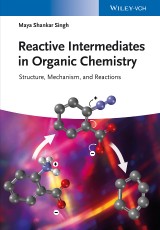Details

Reactive Intermediates in Organic Chemistry
Structure, Mechanism, and Reactions1. Aufl.
|
64,99 € |
|
| Verlag: | Wiley-VCH |
| Format: | |
| Veröffentl.: | 22.01.2014 |
| ISBN/EAN: | 9783527678280 |
| Sprache: | englisch |
| Anzahl Seiten: | 296 |
DRM-geschütztes eBook, Sie benötigen z.B. Adobe Digital Editions und eine Adobe ID zum Lesen.
Beschreibungen
Most reactions in organic chemistry do not proceed in a single step but rather take several steps to yield the desired product. In the course of these multi-step reaction sequences, short-lived intermediates can be generated that quickly convert into other intermediates, reactants, products or side products. As these intermediates are highly reactive, they cannot usually be isolated, but their existence and structure can be proved by theoretical and experimental methods. Using the information obtained, researchers can better understand the underlying reaction mechanism of a certain organic transformation and thus develop novel strategies for efficient organic synthesis.<br> <br> The chapters are clearly structured and are arranged according to the type of intermediate, providing information on the formation, characterization, stereochemistry, stability, and reactivity of the intermediates. Additionally, representative examples and a problem section with different levels of difficulty are included for self-testing the newly acquired knowledge.<br> <br> By providing a deeper understanding of the underlying concepts, this is a musthave reference for PhD and Master Students in organic chemistry, as well as a valuable source of information for chemists in academia and industry working in the field. It is also ideal as primary or supplementary reading for courses on organic chemistry, physical organic chemistry or analytical chemistry.<br>
Preface<br> <br> INTRODUCTION<br> Reaction Mechanism and Reaction Arrows<br> Properties and Characteristics of a Reaction<br> Summary<br> <br> CARBOCATIONS<br> Introduction<br> History<br> Sturctures and Geometry of Carbocations<br> Generation of Carbocation<br> Carbocation Stability<br> Detection of Carbocations<br> Fate of Carbocations<br> Nonclassical Carbocations<br> Radical Cations<br> Summary<br> <br> CARBANIONS<br> Structure and Geometry of Carbanions<br> Generation of Carbanions<br> Stability of Carbanions<br> Reactions of Carbanions<br> Enolate Reactions with Carbonyl Groups<br> Rearrangements of Carbanions<br> Chiral Carbanions<br> Carbanions and Tautomerism<br> Summary<br> <br> RADICALS<br> Introduction<br> Detection and Characterization of Radicals<br> Structure and Bonding of Radicals<br> Generation of Free Radicals<br> Stability of Radicals<br> Reactions of Free Radicals<br> Stereochemistry of Radical Reactions<br> Biradicals<br> Summary<br> <br> CARBENES<br> Structure and Geometry of Carbenes<br> Generation of Carbenes<br> Reactions of Carbenes<br> Carbenes and Carbene Ligands in Organometallic Chemistry<br> Summary<br> <br> NITRENES<br> Introduction<br> Structure and Reactivity<br> Generation of Nitrenes<br> Reactions of Nitrenes<br> Summary<br> <br> MISCELLANEOUS INTERMEDIATES<br> Arynes<br> Ketenes and Cumulenes<br> ortho-Quinone Methides<br> Zwitterions and Dipoles<br> Antiaromatic Systems<br> Tetrahedral Intermediates<br> Summary<br> <br> Index<br> <br>
Maya Shankar Singh obtained his PhD degree in Organic Chemistry from Banaras Hindu University, Varanasi, India in 1986. After postdoctoral research, he joined the Vikram University Ujjain as Assistant Professor in 1990 and moved to Gorakhpur University as Associate Professor in 1998 and then to Banaras Hindu University in 2004, where he became Professor in Organic Chemistry in 2006. During his sabbatical, he visited University of Arizona, USA; Michigan State University, USA; Nagoya Institute of Technology, Japan; Loughborough University, UK and University of Leicester, UK. His research interests are centered on synthetic organic chemistry, in particular the design and discovery of new drug candidates, development of novel building block precursors, new synthetic methodologies (catalytic and stoichiometric) and investigations towards understanding mechanisms, one-pot multi-component domino/tandem reactions, solvent-free reactions, asymmetric synthesis, green reactions and chemistry of ?-oxodithioesters/?-oxothioamides and <-oxoketene-S,S-/N,Sacetals. He has published more than 120 scientific papers and four reviews articles in reputed international journals. Prof. Singh has also authored two textbooks in organic chemistry published by Pearson Education. He is a Fellow of the National Academy of Sciences, India.
Most reactions in organic chemistry do not proceed in a single step but rather take several steps to yield the desired product. In the course of these multi-step reaction sequences, short-lived intermediates can be generated that quickly convert into other intermediates, reactants, products or side products. As these intermediates are highly reactive, they cannot usually be isolated, but their existence and structure can be proved by theoretical and experimental methods. Using the information obtained, researchers can better understand the underlying reaction mechanism of a certain organic transformation and thus develop novel strategies for efficient organic synthesis.<br> <br> The chapters are clearly structured and are arranged according to the type of intermediate, providing information on the formation, characterization, stereochemistry, stability, and reactivity of the intermediates. Additionally, representative examples and a problem section with different levels of difficulty are included for self-testing the newly acquired knowledge.<br> <br> By providing a deeper understanding of the underlying concepts, this is a musthave reference for PhD and Master Students in organic chemistry, as well as a valuable source of information for chemists in academia and industry working in the field. It is also ideal as primary or supplementary reading for courses on organic chemistry, physical organic chemistry or analytical chemistry.<br>

















